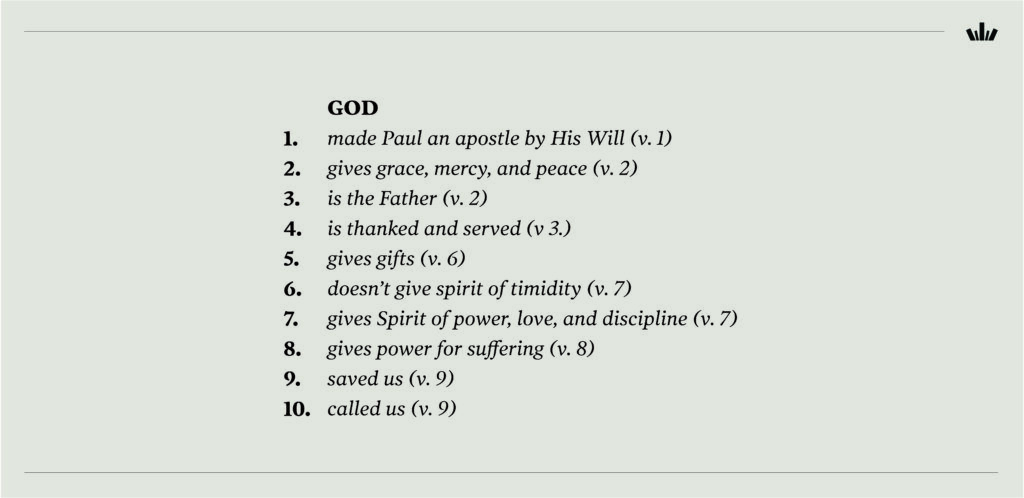For over 50 years, Precept has helped millions of people around the world know God deeply through knowing His Word. We believe that the key to discovering truth for yourself in Scripture is the Precept Bible Study Method.
The Precept Bible Study Method centers around three components, which often overlap in practice: observation, interpretation, and application.
In this blog post, we’re going to focus on Observation—the foundation that must be laid if you want to accurately interpret and properly apply God’s Word.
Make sure you stay tuned as we walk through each of these components, showing you the Precept Bible Study Method in action, so you can start utilizing this life-changing approach to studying God’s Word and be transformed!
Start with Prayer
Before you begin studying any passage of Scripture, seek the Lord in prayer. Whenever we study God’s Word, we need the Holy Spirit to open the eyes of our hearts (Ephesians 1:18) and lead us into truth! And here’s a pro tip: Don’t just open your study in prayer—pray continuously as you read and zero in on the details of the passage in front of you. An attitude of prayer will prepare your heart and mind to behold wonderful things in the Word (Psalm 119:18)!
Context Is Key
How would you respond if someone asked you, “What does the word bark mean?” To give a helpful—and accurate!—answer, you’d likely reply with a question of your own: “Can you use it in a sentence?”
In a sentence about a dog with a loud bark, for example, your answer would probably be that bark refers to the short cry a dog makes. But if a forest was mentioned in the sentence, “the skin of a tree” would be the obvious answer.
This simple scenario demonstrates an important principle in Bible study: context, or “that which the text is in,” always rules in interpretation. To determine what a passage means—and how to apply it our lives—we must first carefully observe its context, that is, the surrounding text.
It’s not as hard as it might sound—when you start by observing the obvious, like facts about people, places, and events, you’ll discover important repeated ideas and themes. Identifying the context is crucial to determining what a passage or verse means and what the Lord may be saying to you through it!
The 5 W’s and an H
Think of the passage of Scripture you’re studying as a witness—and yourself as an interrogator. Like any good journalist would, constantly asking questions of the text is how you’ll find out as many details as possible and get “the whole story”:
- Who?
- What?
- When?
- Where?
- Why?
- How?
When you ask the 5 W’s and an H of the text, and when you let the text provide the answers, you’ll be amazed at what you learn! These questions are the building blocks of precise observation which lay a solid foundation for accurate interpretation.
Here’s a quick example of how to use the 5 W’s and an H using one verse:
Now there was a famine in the land; so Abram went down to Egypt to sojourn there, for the famine was severe in the land.
Genesis 12:10 (NASB)
As we interrogate the text with the 5 W’s and an H, we discover:
Who is this about? Abram.
What was he doing, and where was he going? Going down to Egypt.
Why? There was a famine in the land.
Heads up: Don’t feel like you have to find all 5 W’s and an H every time you question a passage, because they’re not always going to be there. For example, Genesis 12:10 didn’t answer When? or How? Just read the text carefully and answer all the 5 W’s and an H questions you can!
Every part of the entire process of the Precept Bible Study Method is based on asking who, what, when, where, why, and how kinds of questions. They are absolutely vital!
Making Lists
Read through the book you’re studying looking for and identifying people, places, and events. For example, if you made a list on everything you learn about “God” from 2 Timothy 1, it would look something like this:

This process may seem tedious, but as you diligently observe the details, you’ll begin to discern the historical and cultural context in which the author is writing—and you’ll be encouraged by all you can discover for yourself from the text itself about these things, without going to an outside source!
Marking the Text
As you read, marking—using symbols, colors, or a combination of the two—important people, places, and events will help you discern the book’s themes and its main message.
But what if, as in the epistle of James for example, identifying references to people and events doesn’t really help you discover the context of the book? What do you do next? You go to the next obvious thing: You look to see what subjects or topics the book deals with by identifying key words.
Key words are words that are vital to the text. Like a key, they “unlock” the meaning of the text. Key words or phrases, when removed, leave the text devoid of meaning. To underscore an author’s point or purpose for writing, key words are often repeated, which makes them easier to spot.
For example, in 1 John 1, the words “sin,” “light,” “fellowship,” and “darkness” are repeated key words.

When you distinctively mark key words and their synonyms consistently in every book of the Bible you study, you’ll be able to track key subjects and quickly identify significant truths throughout Scripture.
To help you get started, check out this bookmark from Precept!
Remember Why You’re Studying
At this point in the process, you may have more questions than answers—and that’s okay! During the observation stage, you’re getting a big picture overview that forms a solid foundation for accurate interpretation and application. As you continue to study, you’ll zoom in on various details in the text and find many of the answers you’re looking for.
There’s no denying it—studying the Bible this way requires time, patience, and a willingness to allow the text to speak for itself. Yet the vital and thrilling truth is this: God’s Word is living and active, and He is speaking to you through Scripture. Taking the time necessary to carefully observe the text will help you slow down enough to see and hear what God is saying to you. And there is nothing sweeter or more valuable than that!
Getting Started
In upcoming blog posts, we’ll dig deeper into the ins and outs of the Precept Bible Study Method—but if you just can’t wait to begin discovering truth for yourself, here’s how you can get started today:
Register for a Workshop
Precept workshops will help you get more out of your Bible study—from Essentials of the Precept Bible Study Method to How to Study the Psalms, there’s an online workshop coming up that’s perfect for you. Register today!
Join a Group
Precept Bible study groups meet virtually and in person all over the world. Find a group, and start learning how to discover truth for yourself, but not by yourself, today!
Choose a Study
Need help choosing a Bible study that will help you study inductively? With more than 250 unique titles covering every book of the Bible—from book studies to topical studies—Precept has a study that meets you where you are!



